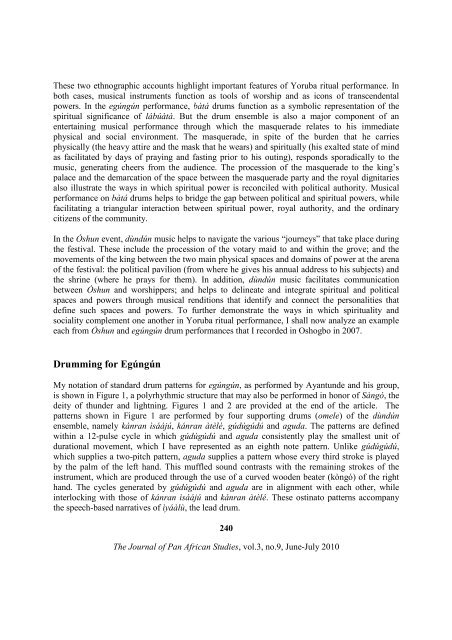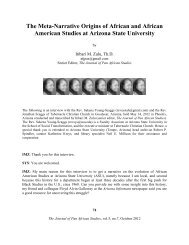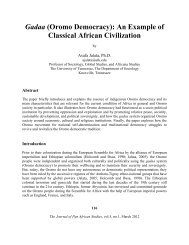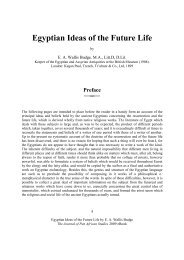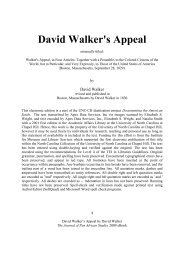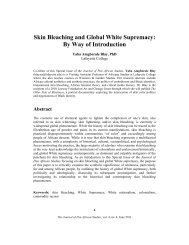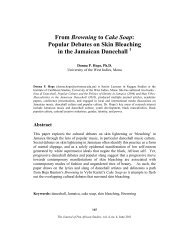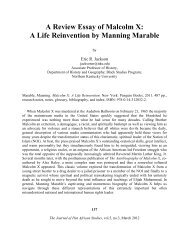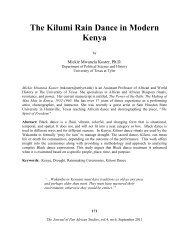Rhythms of the Gods: Music, Spirituality and Social Engagement in ...
Rhythms of the Gods: Music, Spirituality and Social Engagement in ...
Rhythms of the Gods: Music, Spirituality and Social Engagement in ...
Create successful ePaper yourself
Turn your PDF publications into a flip-book with our unique Google optimized e-Paper software.
These two ethnographic accounts highlight important features <strong>of</strong> Yoruba ritual performance. In<br />
both cases, musical <strong>in</strong>struments function as tools <strong>of</strong> worship <strong>and</strong> as icons <strong>of</strong> transcendental<br />
powers. In <strong>the</strong> egúngún performance, bàtá drums function as a symbolic representation <strong>of</strong> <strong>the</strong><br />
spiritual significance <strong>of</strong> lábúàtà. But <strong>the</strong> drum ensemble is also a major component <strong>of</strong> an<br />
enterta<strong>in</strong><strong>in</strong>g musical performance through which <strong>the</strong> masquerade relates to his immediate<br />
physical <strong>and</strong> social environment. The masquerade, <strong>in</strong> spite <strong>of</strong> <strong>the</strong> burden that he carries<br />
physically (<strong>the</strong> heavy attire <strong>and</strong> <strong>the</strong> mask that he wears) <strong>and</strong> spiritually (his exalted state <strong>of</strong> m<strong>in</strong>d<br />
as facilitated by days <strong>of</strong> pray<strong>in</strong>g <strong>and</strong> fast<strong>in</strong>g prior to his out<strong>in</strong>g), responds sporadically to <strong>the</strong><br />
music, generat<strong>in</strong>g cheers from <strong>the</strong> audience. The procession <strong>of</strong> <strong>the</strong> masquerade to <strong>the</strong> k<strong>in</strong>g’s<br />
palace <strong>and</strong> <strong>the</strong> demarcation <strong>of</strong> <strong>the</strong> space between <strong>the</strong> masquerade party <strong>and</strong> <strong>the</strong> royal dignitaries<br />
also illustrate <strong>the</strong> ways <strong>in</strong> which spiritual power is reconciled with political authority. <strong>Music</strong>al<br />
performance on bàtá drums helps to bridge <strong>the</strong> gap between political <strong>and</strong> spiritual powers, while<br />
facilitat<strong>in</strong>g a triangular <strong>in</strong>teraction between spiritual power, royal authority, <strong>and</strong> <strong>the</strong> ord<strong>in</strong>ary<br />
citizens <strong>of</strong> <strong>the</strong> community.<br />
In <strong>the</strong> Òshun event, dùndún music helps to navigate <strong>the</strong> various “journeys” that take place dur<strong>in</strong>g<br />
<strong>the</strong> festival. These <strong>in</strong>clude <strong>the</strong> procession <strong>of</strong> <strong>the</strong> votary maid to <strong>and</strong> with<strong>in</strong> <strong>the</strong> grove; <strong>and</strong> <strong>the</strong><br />
movements <strong>of</strong> <strong>the</strong> k<strong>in</strong>g between <strong>the</strong> two ma<strong>in</strong> physical spaces <strong>and</strong> doma<strong>in</strong>s <strong>of</strong> power at <strong>the</strong> arena<br />
<strong>of</strong> <strong>the</strong> festival: <strong>the</strong> political pavilion (from where he gives his annual address to his subjects) <strong>and</strong><br />
<strong>the</strong> shr<strong>in</strong>e (where he prays for <strong>the</strong>m). In addition, dùndún music facilitates communication<br />
between Òshun <strong>and</strong> worshippers; <strong>and</strong> helps to del<strong>in</strong>eate <strong>and</strong> <strong>in</strong>tegrate spiritual <strong>and</strong> political<br />
spaces <strong>and</strong> powers through musical renditions that identify <strong>and</strong> connect <strong>the</strong> personalities that<br />
def<strong>in</strong>e such spaces <strong>and</strong> powers. To fur<strong>the</strong>r demonstrate <strong>the</strong> ways <strong>in</strong> which spirituality <strong>and</strong><br />
sociality complement one ano<strong>the</strong>r <strong>in</strong> Yoruba ritual performance, I shall now analyze an example<br />
each from Òshun <strong>and</strong> egúngún drum performances that I recorded <strong>in</strong> Oshogbo <strong>in</strong> 2007.<br />
Drumm<strong>in</strong>g for Egúngún<br />
My notation <strong>of</strong> st<strong>and</strong>ard drum patterns for egúngún, as performed by Ayantunde <strong>and</strong> his group,<br />
is shown <strong>in</strong> Figure 1, a polyrhythmic structure that may also be performed <strong>in</strong> honor <strong>of</strong> Sàngó, <strong>the</strong><br />
deity <strong>of</strong> thunder <strong>and</strong> lightn<strong>in</strong>g. Figures 1 <strong>and</strong> 2 are provided at <strong>the</strong> end <strong>of</strong> <strong>the</strong> article. The<br />
patterns shown <strong>in</strong> Figure 1 are performed by four support<strong>in</strong>g drums (omele) <strong>of</strong> <strong>the</strong> dùndún<br />
ensemble, namely kánran ìsáájú, kánran àtèlé, gúdúgúdú <strong>and</strong> aguda. The patterns are def<strong>in</strong>ed<br />
with<strong>in</strong> a 12-pulse cycle <strong>in</strong> which gúdúgúdú <strong>and</strong> aguda consistently play <strong>the</strong> smallest unit <strong>of</strong><br />
durational movement, which I have represented as an eighth note pattern. Unlike gúdúgúdú,<br />
which supplies a two-pitch pattern, aguda supplies a pattern whose every third stroke is played<br />
by <strong>the</strong> palm <strong>of</strong> <strong>the</strong> left h<strong>and</strong>. This muffled sound contrasts with <strong>the</strong> rema<strong>in</strong><strong>in</strong>g strokes <strong>of</strong> <strong>the</strong><br />
<strong>in</strong>strument, which are produced through <strong>the</strong> use <strong>of</strong> a curved wooden beater (kòngó) <strong>of</strong> <strong>the</strong> right<br />
h<strong>and</strong>. The cycles generated by gúdúgúdú <strong>and</strong> aguda are <strong>in</strong> alignment with each o<strong>the</strong>r, while<br />
<strong>in</strong>terlock<strong>in</strong>g with those <strong>of</strong> kánran ìsáájú <strong>and</strong> kánran àtèlé. These ost<strong>in</strong>ato patterns accompany<br />
<strong>the</strong> speech-based narratives <strong>of</strong> ìyáàlù, <strong>the</strong> lead drum.<br />
240<br />
The Journal <strong>of</strong> Pan African Studies, vol.3, no.9, June-July 2010


